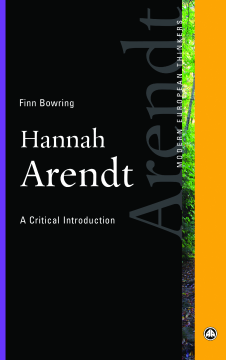
Additional Information
Book Details
Abstract
Hannah Arendt is one of the most famous political theorists of the twentieth century, yet in the social sciences her work has rarely been given the attention it deserves. This careful and comprehensive study introduces Arendt to a wider audience.
Finn Bowring shows how Arendt's writings have engaged with and influenced prominent figures in the sociological canon, and how her ideas may shed light on some of the most pressing social and political problems of today. He explores her critique of Marx, her relationship to Weber, the influence of her work on Habermas and the parallels and discrepancies between her and Foucault. This is a clearly written and scholarly text which surveys the leading debates over Arendt's work, including discussions of totalitarianism, the public sphere and the nature of political responsibility.
This book will bring new perspectives to students and lecturers in sociology and politics.
'An original and highly developed perspective on the influence of Arendt's thinking on the social sciences, just as scholars in a number of related disciplines are beginning to rethink the relevance of Arendt's work beyond political theory'
Dimitris Papadopoulos, Reader in Sociology and Organisation at the University of Leicester and co-author of Escape Routes (Pluto, 2008)
'An excellent, accessible and readable introduction to Arendt's political theory'
Dr Wallace McNeish, Lecturer in Sociology, University of Abertay
Table of Contents
| Section Title | Page | Action | Price |
|---|---|---|---|
| Cover | Cover | ||
| Contents | vii | ||
| A Note on Referencing and Abbreviations | viii | ||
| Introduction: TIme for Action | 1 | ||
| 1. The 'Vita Activa' | 12 | ||
| 2. Critique of Modernity | 40 | ||
| 3. From Action to Power: The Fate of the Political | 64 | ||
| 4. Marxism, Ecology and Culture | 96 | ||
| 5. Feminism, the Social and the Political | 127 | ||
| 6. Imperialism, Racism and Bureaucracy: The Road to Totalitarianism | 164 | ||
| 7. Totalitarianism | 188 | ||
| 8. In Search of the Subject | 217 | ||
| 9. The 'Vita Contemplativa' | 245 | ||
| Conclusion: Going Astray with Arendt | 268 | ||
| Notes | 275 | ||
| References | 282 | ||
| Index | 293 |
